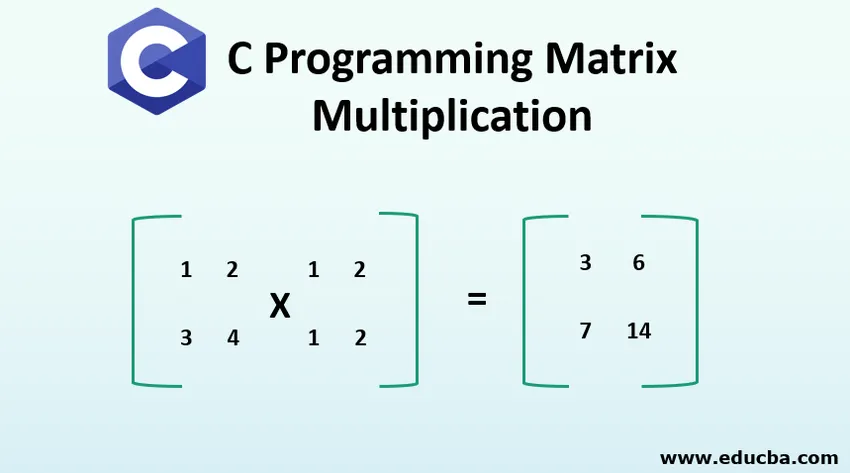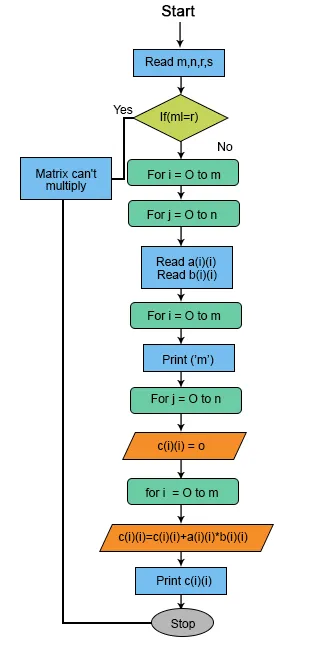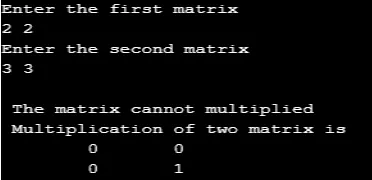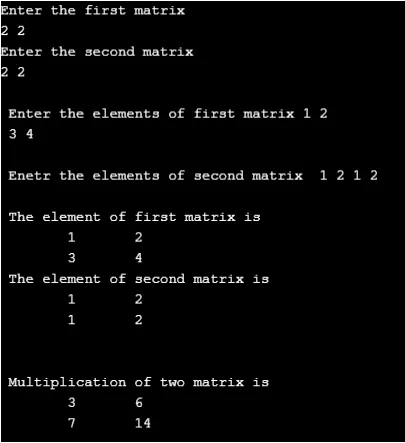
Introduzione alla moltiplicazione di matrici nella programmazione C.
Nell'articolo C Programmazione Matrice Moltiplicazione una matrice è una griglia che viene utilizzata per memorizzare i dati in un formato strutturato. Viene spesso utilizzato con una tabella, in cui i dati sono rappresentati in righe orizzontali e colonne verticali. Le matrici sono spesso utilizzate nei linguaggi di programmazione e sono utilizzate per rappresentare i dati in una struttura grafica. Nella programmazione se l'utente desidera moltiplicare, aggiungere, sottrarre e dividere due matrici, l'ordine della matrice deve essere dichiarato per primo. Dopo che l'ordine della matrice è stato dichiarato per la prima e la seconda matrice, l'utente deve inserire gli elementi (input) per le matrici. Se l'ordine della matrice non è proporzionato l'uno all'altro, verrà visualizzato il messaggio di errore che viene impiantato da un programmatore nell'istruzione condition. Se una matrice contiene solo una riga, viene chiamata vettore riga e se contiene solo una colonna, viene chiamata vettore colonna.
Una matrice che contiene lo stesso numero di righe e colonne, quindi viene chiamata matrice quadrata. Matrix viene utilizzato per archiviare un gruppo di dati correlati. Alcuni dei linguaggi di programmazione vengono utilizzati per supportare le matrici come tipo di dati che offre maggiore flessibilità rispetto a un array statico. Invece di archiviare i valori in una matrice, può essere archiviato come una singola variabile, un programma può accedere ed eseguire operazioni sui dati in modo più efficiente. Nella programmazione in matrice C le moltiplicazioni vengono fatte usando matrici, funzioni, puntatori. Discuteremo quindi un algoritmo per la moltiplicazione di matrici insieme al diagramma di flusso, che può essere usato per scrivere il codice di programmazione per la moltiplicazione di matrici 3 × 3 in un linguaggio di alto livello. Questa spiegazione dettagliata ti aiuterà ad analizzare il meccanismo di funzionamento della moltiplicazione di matrici e ti aiuterà a capire come scrivere il codice.
Algoritmo di moltiplicazione della matrice di programmazione C.
Passaggio 1: avviare il programma.
Passaggio 2: immettere la riga e la colonna della prima matrice (a).
Passaggio 3: immettere la riga e la colonna della seconda matrice (b).
Passaggio 4: inserire gli elementi della prima matrice (a).
Passaggio 5: inserire gli elementi della seconda matrice (b).
Passaggio 6: stampare gli elementi della prima (a) matrice in forma di matrice.
Passaggio 7: stampare gli elementi della seconda (b) matrice in forma di matrice.
Passaggio 8: imposta un ciclo fino alla riga.
Passaggio 9: imposta un loop interno fino alla colonna.
Passaggio 10: imposta un altro loop interno fino alla colonna.
Passaggio 11: moltiplicare la prima (a) e la seconda (b) matrice e memorizzare l'elemento nella terza matrice (c)
Passaggio 12: stampare la matrice finale.
Passaggio 13: interrompere il programma.
Diagramma di flusso della moltiplicazione di matrici

Esempio di moltiplicazione della matrice di programmazione C.
Il programma C esegue la moltiplicazione della matrice, diamo un'occhiata ad alcuni esempi.
Codice:
#include
void main()
(
int a(25)(25), b(25)(25), c(25)(25), i, j, k, r, s;
int m, n;
printf("Enter the first matrix\n");
scanf("%d%d", &m, &n);
printf("Enter the second matrix\n");
scanf("%d%d", &r, &s);
if(m!=r)
printf("\n The matrix cannot multiplied");
else
(
printf("\n Enter the elements of first matrix ");
for(i= 0;i (
for(j=0;j scanf("\t%d", &a(i)(j));
)
printf("\n Enetr the elements of second matrix ");
for(i=0;i (
for(j=0;j scanf("\t%d", &b(i)(j));
)
printf("\n The element of first matrix is");
for(i=0;i (
printf("\n");
for(j=0;j printf("\t%d", a(i)(j));
)
printf("\n The element of second matrix is");
for(i=0;i (
printf("\n");
for(j=0;j printf("\t%d", b(i)(j));
)
for(i=0;i (
printf("\n");
for(j=0;j (
c(i)(j)=0;
for(k=0;k c(i)(j)=c(i)(j)+a(i)(k)*b(k)(j);
)
)
)
printf("\n Multiplication of two matrix is");
for(i=0;i (
printf("\n");
for(j=0;j printf("\t%d", c(i)(j));
)
)#include
void main()
(
int a(25)(25), b(25)(25), c(25)(25), i, j, k, r, s;
int m, n;
printf("Enter the first matrix\n");
scanf("%d%d", &m, &n);
printf("Enter the second matrix\n");
scanf("%d%d", &r, &s);
if(m!=r)
printf("\n The matrix cannot multiplied");
else
(
printf("\n Enter the elements of first matrix ");
for(i= 0;i (
for(j=0;j scanf("\t%d", &a(i)(j));
)
printf("\n Enetr the elements of second matrix ");
for(i=0;i (
for(j=0;j scanf("\t%d", &b(i)(j));
)
printf("\n The element of first matrix is");
for(i=0;i (
printf("\n");
for(j=0;j printf("\t%d", a(i)(j));
)
printf("\n The element of second matrix is");
for(i=0;i (
printf("\n");
for(j=0;j printf("\t%d", b(i)(j));
)
for(i=0;i (
printf("\n");
for(j=0;j (
c(i)(j)=0;
for(k=0;k c(i)(j)=c(i)(j)+a(i)(k)*b(k)(j);
)
)
)
printf("\n Multiplication of two matrix is");
for(i=0;i (
printf("\n");
for(j=0;j printf("\t%d", c(i)(j));
)
)#include
void main()
(
int a(25)(25), b(25)(25), c(25)(25), i, j, k, r, s;
int m, n;
printf("Enter the first matrix\n");
scanf("%d%d", &m, &n);
printf("Enter the second matrix\n");
scanf("%d%d", &r, &s);
if(m!=r)
printf("\n The matrix cannot multiplied");
else
(
printf("\n Enter the elements of first matrix ");
for(i= 0;i (
for(j=0;j scanf("\t%d", &a(i)(j));
)
printf("\n Enetr the elements of second matrix ");
for(i=0;i (
for(j=0;j scanf("\t%d", &b(i)(j));
)
printf("\n The element of first matrix is");
for(i=0;i (
printf("\n");
for(j=0;j printf("\t%d", a(i)(j));
)
printf("\n The element of second matrix is");
for(i=0;i (
printf("\n");
for(j=0;j printf("\t%d", b(i)(j));
)
for(i=0;i (
printf("\n");
for(j=0;j (
c(i)(j)=0;
for(k=0;k c(i)(j)=c(i)(j)+a(i)(k)*b(k)(j);
)
)
)
printf("\n Multiplication of two matrix is");
for(i=0;i (
printf("\n");
for(j=0;j printf("\t%d", c(i)(j));
)
)#include
void main()
(
int a(25)(25), b(25)(25), c(25)(25), i, j, k, r, s;
int m, n;
printf("Enter the first matrix\n");
scanf("%d%d", &m, &n);
printf("Enter the second matrix\n");
scanf("%d%d", &r, &s);
if(m!=r)
printf("\n The matrix cannot multiplied");
else
(
printf("\n Enter the elements of first matrix ");
for(i= 0;i (
for(j=0;j scanf("\t%d", &a(i)(j));
)
printf("\n Enetr the elements of second matrix ");
for(i=0;i (
for(j=0;j scanf("\t%d", &b(i)(j));
)
printf("\n The element of first matrix is");
for(i=0;i (
printf("\n");
for(j=0;j printf("\t%d", a(i)(j));
)
printf("\n The element of second matrix is");
for(i=0;i (
printf("\n");
for(j=0;j printf("\t%d", b(i)(j));
)
for(i=0;i (
printf("\n");
for(j=0;j (
c(i)(j)=0;
for(k=0;k c(i)(j)=c(i)(j)+a(i)(k)*b(k)(j);
)
)
)
printf("\n Multiplication of two matrix is");
for(i=0;i (
printf("\n");
for(j=0;j printf("\t%d", c(i)(j));
)
)#include
void main()
(
int a(25)(25), b(25)(25), c(25)(25), i, j, k, r, s;
int m, n;
printf("Enter the first matrix\n");
scanf("%d%d", &m, &n);
printf("Enter the second matrix\n");
scanf("%d%d", &r, &s);
if(m!=r)
printf("\n The matrix cannot multiplied");
else
(
printf("\n Enter the elements of first matrix ");
for(i= 0;i (
for(j=0;j scanf("\t%d", &a(i)(j));
)
printf("\n Enetr the elements of second matrix ");
for(i=0;i (
for(j=0;j scanf("\t%d", &b(i)(j));
)
printf("\n The element of first matrix is");
for(i=0;i (
printf("\n");
for(j=0;j printf("\t%d", a(i)(j));
)
printf("\n The element of second matrix is");
for(i=0;i (
printf("\n");
for(j=0;j printf("\t%d", b(i)(j));
)
for(i=0;i (
printf("\n");
for(j=0;j (
c(i)(j)=0;
for(k=0;k c(i)(j)=c(i)(j)+a(i)(k)*b(k)(j);
)
)
)
printf("\n Multiplication of two matrix is");
for(i=0;i (
printf("\n");
for(j=0;j printf("\t%d", c(i)(j));
)
)#include
void main()
(
int a(25)(25), b(25)(25), c(25)(25), i, j, k, r, s;
int m, n;
printf("Enter the first matrix\n");
scanf("%d%d", &m, &n);
printf("Enter the second matrix\n");
scanf("%d%d", &r, &s);
if(m!=r)
printf("\n The matrix cannot multiplied");
else
(
printf("\n Enter the elements of first matrix ");
for(i= 0;i (
for(j=0;j scanf("\t%d", &a(i)(j));
)
printf("\n Enetr the elements of second matrix ");
for(i=0;i (
for(j=0;j scanf("\t%d", &b(i)(j));
)
printf("\n The element of first matrix is");
for(i=0;i (
printf("\n");
for(j=0;j printf("\t%d", a(i)(j));
)
printf("\n The element of second matrix is");
for(i=0;i (
printf("\n");
for(j=0;j printf("\t%d", b(i)(j));
)
for(i=0;i (
printf("\n");
for(j=0;j (
c(i)(j)=0;
for(k=0;k c(i)(j)=c(i)(j)+a(i)(k)*b(k)(j);
)
)
)
printf("\n Multiplication of two matrix is");
for(i=0;i (
printf("\n");
for(j=0;j printf("\t%d", c(i)(j));
)
)#include
void main()
(
int a(25)(25), b(25)(25), c(25)(25), i, j, k, r, s;
int m, n;
printf("Enter the first matrix\n");
scanf("%d%d", &m, &n);
printf("Enter the second matrix\n");
scanf("%d%d", &r, &s);
if(m!=r)
printf("\n The matrix cannot multiplied");
else
(
printf("\n Enter the elements of first matrix ");
for(i= 0;i (
for(j=0;j scanf("\t%d", &a(i)(j));
)
printf("\n Enetr the elements of second matrix ");
for(i=0;i (
for(j=0;j scanf("\t%d", &b(i)(j));
)
printf("\n The element of first matrix is");
for(i=0;i (
printf("\n");
for(j=0;j printf("\t%d", a(i)(j));
)
printf("\n The element of second matrix is");
for(i=0;i (
printf("\n");
for(j=0;j printf("\t%d", b(i)(j));
)
for(i=0;i (
printf("\n");
for(j=0;j (
c(i)(j)=0;
for(k=0;k c(i)(j)=c(i)(j)+a(i)(k)*b(k)(j);
)
)
)
printf("\n Multiplication of two matrix is");
for(i=0;i (
printf("\n");
for(j=0;j printf("\t%d", c(i)(j));
)
)#include
void main()
(
int a(25)(25), b(25)(25), c(25)(25), i, j, k, r, s;
int m, n;
printf("Enter the first matrix\n");
scanf("%d%d", &m, &n);
printf("Enter the second matrix\n");
scanf("%d%d", &r, &s);
if(m!=r)
printf("\n The matrix cannot multiplied");
else
(
printf("\n Enter the elements of first matrix ");
for(i= 0;i (
for(j=0;j scanf("\t%d", &a(i)(j));
)
printf("\n Enetr the elements of second matrix ");
for(i=0;i (
for(j=0;j scanf("\t%d", &b(i)(j));
)
printf("\n The element of first matrix is");
for(i=0;i (
printf("\n");
for(j=0;j printf("\t%d", a(i)(j));
)
printf("\n The element of second matrix is");
for(i=0;i (
printf("\n");
for(j=0;j printf("\t%d", b(i)(j));
)
for(i=0;i (
printf("\n");
for(j=0;j (
c(i)(j)=0;
for(k=0;k c(i)(j)=c(i)(j)+a(i)(k)*b(k)(j);
)
)
)
printf("\n Multiplication of two matrix is");
for(i=0;i (
printf("\n");
for(j=0;j printf("\t%d", c(i)(j));
)
)#include
void main()
(
int a(25)(25), b(25)(25), c(25)(25), i, j, k, r, s;
int m, n;
printf("Enter the first matrix\n");
scanf("%d%d", &m, &n);
printf("Enter the second matrix\n");
scanf("%d%d", &r, &s);
if(m!=r)
printf("\n The matrix cannot multiplied");
else
(
printf("\n Enter the elements of first matrix ");
for(i= 0;i (
for(j=0;j scanf("\t%d", &a(i)(j));
)
printf("\n Enetr the elements of second matrix ");
for(i=0;i (
for(j=0;j scanf("\t%d", &b(i)(j));
)
printf("\n The element of first matrix is");
for(i=0;i (
printf("\n");
for(j=0;j printf("\t%d", a(i)(j));
)
printf("\n The element of second matrix is");
for(i=0;i (
printf("\n");
for(j=0;j printf("\t%d", b(i)(j));
)
for(i=0;i (
printf("\n");
for(j=0;j (
c(i)(j)=0;
for(k=0;k c(i)(j)=c(i)(j)+a(i)(k)*b(k)(j);
)
)
)
printf("\n Multiplication of two matrix is");
for(i=0;i (
printf("\n");
for(j=0;j printf("\t%d", c(i)(j));
)
)#include
void main()
(
int a(25)(25), b(25)(25), c(25)(25), i, j, k, r, s;
int m, n;
printf("Enter the first matrix\n");
scanf("%d%d", &m, &n);
printf("Enter the second matrix\n");
scanf("%d%d", &r, &s);
if(m!=r)
printf("\n The matrix cannot multiplied");
else
(
printf("\n Enter the elements of first matrix ");
for(i= 0;i (
for(j=0;j scanf("\t%d", &a(i)(j));
)
printf("\n Enetr the elements of second matrix ");
for(i=0;i (
for(j=0;j scanf("\t%d", &b(i)(j));
)
printf("\n The element of first matrix is");
for(i=0;i (
printf("\n");
for(j=0;j printf("\t%d", a(i)(j));
)
printf("\n The element of second matrix is");
for(i=0;i (
printf("\n");
for(j=0;j printf("\t%d", b(i)(j));
)
for(i=0;i (
printf("\n");
for(j=0;j (
c(i)(j)=0;
for(k=0;k c(i)(j)=c(i)(j)+a(i)(k)*b(k)(j);
)
)
)
printf("\n Multiplication of two matrix is");
for(i=0;i (
printf("\n");
for(j=0;j printf("\t%d", c(i)(j));
)
)#include
void main()
(
int a(25)(25), b(25)(25), c(25)(25), i, j, k, r, s;
int m, n;
printf("Enter the first matrix\n");
scanf("%d%d", &m, &n);
printf("Enter the second matrix\n");
scanf("%d%d", &r, &s);
if(m!=r)
printf("\n The matrix cannot multiplied");
else
(
printf("\n Enter the elements of first matrix ");
for(i= 0;i (
for(j=0;j scanf("\t%d", &a(i)(j));
)
printf("\n Enetr the elements of second matrix ");
for(i=0;i (
for(j=0;j scanf("\t%d", &b(i)(j));
)
printf("\n The element of first matrix is");
for(i=0;i (
printf("\n");
for(j=0;j printf("\t%d", a(i)(j));
)
printf("\n The element of second matrix is");
for(i=0;i (
printf("\n");
for(j=0;j printf("\t%d", b(i)(j));
)
for(i=0;i (
printf("\n");
for(j=0;j (
c(i)(j)=0;
for(k=0;k c(i)(j)=c(i)(j)+a(i)(k)*b(k)(j);
)
)
)
printf("\n Multiplication of two matrix is");
for(i=0;i (
printf("\n");
for(j=0;j printf("\t%d", c(i)(j));
)
)#include
void main()
(
int a(25)(25), b(25)(25), c(25)(25), i, j, k, r, s;
int m, n;
printf("Enter the first matrix\n");
scanf("%d%d", &m, &n);
printf("Enter the second matrix\n");
scanf("%d%d", &r, &s);
if(m!=r)
printf("\n The matrix cannot multiplied");
else
(
printf("\n Enter the elements of first matrix ");
for(i= 0;i (
for(j=0;j scanf("\t%d", &a(i)(j));
)
printf("\n Enetr the elements of second matrix ");
for(i=0;i (
for(j=0;j scanf("\t%d", &b(i)(j));
)
printf("\n The element of first matrix is");
for(i=0;i (
printf("\n");
for(j=0;j printf("\t%d", a(i)(j));
)
printf("\n The element of second matrix is");
for(i=0;i (
printf("\n");
for(j=0;j printf("\t%d", b(i)(j));
)
for(i=0;i (
printf("\n");
for(j=0;j (
c(i)(j)=0;
for(k=0;k c(i)(j)=c(i)(j)+a(i)(k)*b(k)(j);
)
)
)
printf("\n Multiplication of two matrix is");
for(i=0;i (
printf("\n");
for(j=0;j printf("\t%d", c(i)(j));
)
)#include
void main()
(
int a(25)(25), b(25)(25), c(25)(25), i, j, k, r, s;
int m, n;
printf("Enter the first matrix\n");
scanf("%d%d", &m, &n);
printf("Enter the second matrix\n");
scanf("%d%d", &r, &s);
if(m!=r)
printf("\n The matrix cannot multiplied");
else
(
printf("\n Enter the elements of first matrix ");
for(i= 0;i (
for(j=0;j scanf("\t%d", &a(i)(j));
)
printf("\n Enetr the elements of second matrix ");
for(i=0;i (
for(j=0;j scanf("\t%d", &b(i)(j));
)
printf("\n The element of first matrix is");
for(i=0;i (
printf("\n");
for(j=0;j printf("\t%d", a(i)(j));
)
printf("\n The element of second matrix is");
for(i=0;i (
printf("\n");
for(j=0;j printf("\t%d", b(i)(j));
)
for(i=0;i (
printf("\n");
for(j=0;j (
c(i)(j)=0;
for(k=0;k c(i)(j)=c(i)(j)+a(i)(k)*b(k)(j);
)
)
)
printf("\n Multiplication of two matrix is");
for(i=0;i (
printf("\n");
for(j=0;j printf("\t%d", c(i)(j));
)
)#include
void main()
(
int a(25)(25), b(25)(25), c(25)(25), i, j, k, r, s;
int m, n;
printf("Enter the first matrix\n");
scanf("%d%d", &m, &n);
printf("Enter the second matrix\n");
scanf("%d%d", &r, &s);
if(m!=r)
printf("\n The matrix cannot multiplied");
else
(
printf("\n Enter the elements of first matrix ");
for(i= 0;i (
for(j=0;j scanf("\t%d", &a(i)(j));
)
printf("\n Enetr the elements of second matrix ");
for(i=0;i (
for(j=0;j scanf("\t%d", &b(i)(j));
)
printf("\n The element of first matrix is");
for(i=0;i (
printf("\n");
for(j=0;j printf("\t%d", a(i)(j));
)
printf("\n The element of second matrix is");
for(i=0;i (
printf("\n");
for(j=0;j printf("\t%d", b(i)(j));
)
for(i=0;i (
printf("\n");
for(j=0;j (
c(i)(j)=0;
for(k=0;k c(i)(j)=c(i)(j)+a(i)(k)*b(k)(j);
)
)
)
printf("\n Multiplication of two matrix is");
for(i=0;i (
printf("\n");
for(j=0;j printf("\t%d", c(i)(j));
)
)
Produzione:


Funzionamento della moltiplicazione della matrice di programmazione C.
- Nel programma sopra, abbiamo inizializzato le variabili e le matrici all'interno del metodo principale nel tipo di dati intero (int).
- Dopo la parte di inizializzazione, otteniamo l'ordine della matrice dall'utente per la prima matrice, quindi contemporaneamente l'utente deve dichiarare l'ordine della seconda matrice.
- Una volta dichiarato l'ordine delle matrici, verrà eseguita la parte condizione, il programma continuerà a essere eseguito solo se l'ordine soddisfa la condizione oppure il programma verrà terminato o arrestato in quella parte stessa.
- Una volta soddisfatta la condizione, l'utente deve inserire gli elementi della matrice come input durante il runtime.
- Viene calcolata la moltiplicazione della matrice di input dell'utente.
- Il programma matrice sopra riportato è semplice e può calcolare l'aggiornamento 25 × 25, quindi possiamo semplicemente modificare l'array secondo i numeri richiesti.
Vantaggi della moltiplicazione della matrice di programmazione C.
- Il linguaggio di programmazione C supporta la matrice come tipo di dati e offre maggiore flessibilità. Inoltre, consuma meno memoria durante l'elaborazione.
- Memorizzando i valori in una matrice anziché come singole variabili, il programma C può accedere ed eseguire le operazioni sui dati in modo più efficiente.
- È più facile estrarre informazioni sulla rotazione degli oggetti, e anche facile da manipolare nel programma C.
Conclusione
La moltiplicazione della matrice viene ripetutamente utilizzata nei programmi per rappresentare una struttura grafica di dati, che viene utilizzata per memorizzare più vettori e viene anche utilizzata in molte applicazioni come la risoluzione di equazioni lineari e altro ancora. Molte ricerche sono state fatte sulla moltiplicazione di matrici utilizzando un numero minimo di operazioni.
Articolo raccomandato
Questa è una guida alla moltiplicazione della matrice di programmazione C. Qui discutiamo del funzionamento della manipolazione della matrice, dell'algoritmo, del diagramma di flusso e degli esempi insieme a diversi vantaggi nella programmazione c. Puoi anche consultare i nostri altri articoli suggeriti per saperne di più -
- Introduzione alle matrici nella programmazione C.
- Pattern nella programmazione C - (Esempi)
- C Domande di intervista di programmazione | Top 13
- Cos'è il linguaggio di programmazione R?
- Matrici nella struttura dei dati